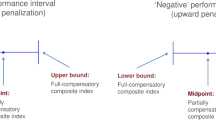Abstract
In the paper, a novel practical approach to construct a composite indicator (CI) is proposed. The key idea is to decide the weights of sub-indicators in constructing a composite indicator by maximizing the sum of squared correlations between the CI and sub-indicators. The CI obtained in this fashion has the maximum sum of squared correlations among all linear estimators. In addition, the simple, exact and explicit solutions of weights are proposed under the condition of non-negative irreducible matrix. Moreover, under this particular condition, the proposed method will become the principal component analysis. For illustration purpose, the proposed novel approach is utilized to calculate Sustainable Energy Index and Human Development Index which are two often-used cases to compare models in the literatures. The results show that the power of the proposed method outweigh the methods of Hatefi, et al. (2010) and Zhou, et al. (2007) in terms of the sum of absolute values of all sub-indicators’ correlations
Similar content being viewed by others
References
OECD, Handbook on Constructing Composite Indicators: Methodology and User Guide, OECD Publishing, OECD, 2008.
Timmermann A, Forecast combinations, Handbook of Economic Forecasting, Volume 1, Handbook of Economics (edited by Elliott G, Granger C, and Timmermann A), Elsevier, Horth-Holland, 2006, 24: 135–196.
Saisana M, Saltelli A, and Tarantola S, Uncertainty and sensitivity analysis techniques as tools for the quality assessment of composite indicators, Journal of the Royal Statistical Society A, 2005, 168(sn2): 307–323.
Zhou P, Ang B W, and Poh K L, A mathematical programming approach to constructing composite indicators, Ecological Economics, 2007, 62(2): 291–297.
Hatefi S M and Torabi S A, A common weight MCDA-DEA approach to construct composite indicators, Ecological Economics, 2010, 70(1): 114–120.
Zeleny M, Multiple Criteria Decision Making, McGraw-Hill Press, New York, 1982.
Figueira J, Greco S, and Ehrgott M, Multiple Criteria Decision Analysis: State of the Art Surveys, Springer Press, New York, 2005.
Zhou P, Ang B W, and Poh K L, Comparing aggregating methods for constructing the composite environmental index: An objective measure, Ecological Economics, 2006, 59(3): 305–311.
Nardo M, Saisana M, Saltelli A, Tarantola S, Hoffman A, and Giovannini E, Handbook on Constructing Composite Indicators: Methodology and User Guide, OECD Statistics Working Paper 2005/3. Available at: http://www.olis.oecd.org/olis/2005doc.nsf/LinkTo/std-doc(2005)3, 2005.
Hope C, Parker J, and Peake S, A pilot environmental index for the UK in the 1980s, Energy Policy, 1992, 20(4): 335–343.
Charnes A, Cooper W W, and Rhodes E, Measuring the efficiency of decision making units, European Journal of Operational Research, 1978, 2(6): 429–444.
Cooper W W, Seiford L M, and Tone T, Introduction to Data Envelopment Analysis and Its Uses: With DEA-Solver Software and References, Springer, New York, 2006.
Cherchye L, Moesen W, Rogge N, and Van-Puyenbroeck T, An introduction to ‘benefit of the doubt’ composite indicators, Social Indicators Research, 2007, 82(1): 111–145.
Cherchye L, Moesen W, Rogge N, Van-Puyenbroeck T, Saisana M, Saltelli A, Liska R, and Tarantola S, Creating composite indicators with DEA and robustness analysis: The case of the Technology Achievement Index, Journal of the Operational Research Society, 2008, 59(2): 239–251.
Poveda A C, Economic development and growth in Colombia: An empirical analysis with superefficiency DEA and panel data models, Socio-Economic Planning Sciences, 2011, 45(4): 154–164.
Pöldaru R and Roots J, A PCA-DEA approach to measure the quality of life in Estonian counties, Socio-Economic Planning Sciences, 2014, 48(1): 65–73.
Felice F D, Campagiorni F, and Petrillo A, Economic and environmental evaluation via an integrated method based on LCA and MCDA, Procedia—Social and Behavioral Sciences, 2013, 99(6): 1–10.
Son Y S and Baek J, A modified correlation coefficient based similarity measure for clustering time-course gene expression data, Pattern Recognition Letters, 2008, 29(3): 232–242.
Soranno P A, Webster K E, Riera J L, Kratz T K, Baron J S, Bukaveckas P A, Kling G W, White D S, Caine N, Lathrop R C, and Leavitt P R, Spatial variation among lakes within landscapes: Ecological organization along lake chains, Ecosystems, 1999, 2(5): 395–410.
Higgs R E, Zahn J A, Gygi J D, and Hilton M D, Rapid method to estimate the presence of second metabolites in microbial extracts, Applied and Environmental Microbiology, 2001, 27(1): 371–376.
Van-Den B A E, Willems R, London N, and Stobberingh E E, Antibiotic resistance of faecal enterococci in poultry, poultry farmers and poultry slaughterers, Journal of Antimicrobial Chemotherapy, 2002, 49(3): 497–505.
Jagannathan R, On some properties of programming problems in parametric form pertaining to fractional programming, Management Science, 1966, 12(7): 609–615.
Zhang A and Hayashi S, Celis-Dennis-Tapia based approach to quadratic fractional programming problems with two quadratic constraints, Technical Report, 2010–012, Kyoto University, Kyoto, 2012.
Mcshane E J, Integration, Princeton University Press, Princeton, 1944.
Jefferson M, Sustainable energy development: Performance and prospects, Renewable Energy, 2006, 31(3): 571–582.
Despotis D K, Measuring human development via data envelopment analysis: The case of Asia and the Pacific, Omega, 2005, 33(5): 385–390.
Author information
Authors and Affiliations
Corresponding author
Additional information
This research was supported by National Natural Science Foundation of China under Grant No. 71003100,the Fundamental Research Funds for the Central Universities, and the Research Funds of Renmin University ofChina under Grant No.11XNK027.
This paper was recommended for publication by Editor ZOU Guohua.
Rights and permissions
About this article
Cite this article
Wu, W., Wang, X. A Novel approach to construct a composite indicator by maximizing its sum of squared correlations with Sub-indicators. J Syst Sci Complex 28, 925–937 (2015). https://doi.org/10.1007/s11424-014-3089-6
Received:
Revised:
Published:
Issue Date:
DOI: https://doi.org/10.1007/s11424-014-3089-6




